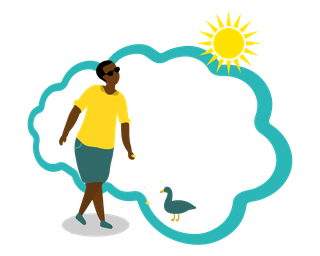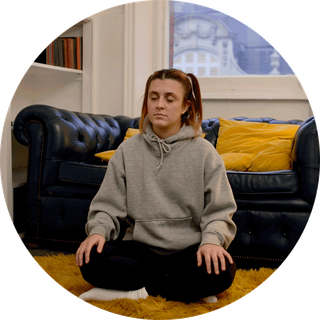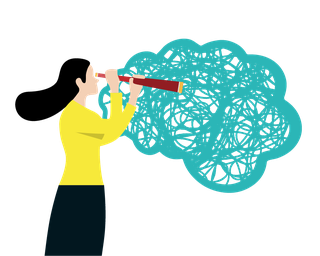What is mindfulness?
Perhaps you have heard of mindfulness but are not sure what it means, how to get started or if it's right for you.
Watch our video to hear from a mindfulness expert. She explains what mindfulness is, describes mindfulness techniques you can try and gives tips on how to start living in a mindful way.
Video: What is mindfulness? Part 1
In our part 1 video, registered psychologist and mindfulness expert Dr. Becky Spelman explains what mindfulness means, and offers practical techniques, advice and guidance on how to start living in a mindful way.
What does 'mindfulness' mean?
Mindfulness is about living more in the present moment, appreciating the here and now, and not dwelling too much on the past or future.
While we have some control over the present, we cannot go back and change things that have already happened. We also have less control over future events than we might think.
This means we can spend a lot of energy worrying when it could be more beneficial to focus on and enjoy what is happening right now.
Mindful living means paying attention to the present, appreciating what is happening and enjoying the simple things in life.
This can help us to feel calmer, reduce stress or anxiety, sleep better and might help us cope better with difficult situations.
Mindfulness tips and techniques
Here are some tips that you might find helpful when you start practising mindfulness.

1. Be more aware of the world around you
Take a minute to look around the room you're in, and really notice what's around you – the shape, colour and texture of each object.
You can do the same outdoors as spending time in green spaces can really help with your mental health. You do not need to live in the countryside – a trip to your local park can work wonders.
The aim is simply to focus your mind on the physical world around you rather than on the worries in your head.
Next time you're outside, try one of the following exercises to help you mindfully experience nature.

Pay attention to the air
When you're walking, really notice the air brushing past your skin. Notice how it feels against your cheeks – is it warm or cold?
Try moving faster or slower and see how the sensations are different.

Use all your senses
Choose a tree or plant and focus on it using all your senses.
This could be as simple as smelling a flower, observing the different shades of green on the leaves and then feeling a petal between your fingers.

2. Be more aware of your thoughts
Try to take a step back from your thoughts, as if you're watching them come and go in your mind. This can help you feel less controlled by them.
You could also try naming them, especially ones that keep popping into your head.
For example, you might say: "Ah, here comes the thought that I always fail." Just acknowledging it may lessen its power over you.
Try this when something disappointing or stressful happens, and see if it works for you.

3. Be more aware of your body
Struggling with our mental health can often mean we get caught up in our thoughts. Focusing more on what's going on in your body can help stop this.
This just means paying more attention to how your body interacts with the space you're in, and how things look, feel, sound and smell in the world around you rather than your thoughts about them.
The aim is to make you feel calmer and more centred, and to focus your mind in the moment rather than letting it drift into worrying about other things.
Try these 2 exercises to see if they help.

Ground yourself
While sitting down, try placing your feet squarely on the ground an even distance apart.
Really notice the weight of them. Think about their place on the floor and how they feel flat on the ground. Are they heavy or light?

Focus on your surroundings
If you're climbing stairs, run your hands along the banister and pay attention to how it feels.
Notice the texture and temperature of the metal or wood and the feel of any small bumps or pieces of flaking paint.
The three Cs of mindfulness
There's another way we can look at mindfulness that may also be helpful. These are the three Cs of mindfulness: curiosity, compassion, and calm centre.
Watch part 2 of our video or carry on reading to discover more.
Video: What is mindfulness? Part 2 – the 3 Cs
In our part 2 video, Dr. Becky Spelman takes us through a different way of looking at and understanding mindfulness.
Practising mindfulness
If the guidance and techniques on this page appeal to you, you might find it helpful to try living in a more mindful way.
Create a mindful routine
Try setting aside a small amount of time each day to do some of the exercises suggested above – and think up similar ones for yourself.
When you hit a difficult situation, try to put into practice some of what you have learnt, so you can react thoughtfully rather than emotionally. Hopefully this will lead to better outcomes.
To start with, you will find you need to consciously practise mindfulness. But over time, it should become more natural and eventually automatic.
What next
If you find mindfulness is working for you, try taking a step further by learning how to meditate.
Meditation simply offers a way to take a moment to stop and be calm.

If mindfulness is not for you
Mindfulness works well to reduce feelings of anxiety, stress and low mood for some people.
However, it may not be right for everyone and it's OK if it does not appeal to you.
We have plenty of other useful things you can try, like our series of self-help cognitive behavioural therapy (CBT) videos and techniques.

Self-help CBT techniques
Learn about CBT, watch video guides and try techniques to deal with worries, solve problems and boost your mental wellbeing.
Find more ideas to try in mental wellbeing tips


